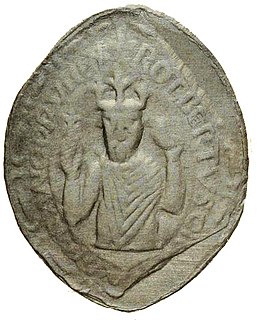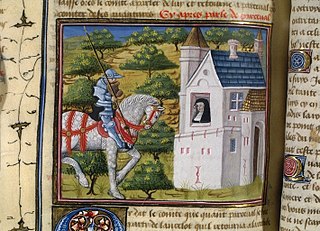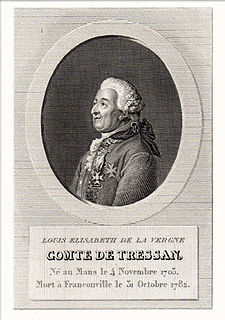Related Research Articles

Pope Sylvester II, originally known as Gerbert of Aurillac, was a French-born scholar and teacher who served as the bishop of Rome and ruled the Papal States from 999 to his death. He endorsed and promoted study of Arab and Greco-Roman arithmetic, mathematics and astronomy, reintroducing to Europe the abacus and armillary sphere, which had been lost to Latin Europe since the end of the Greco-Roman era. He is said to be the first to introduce in Europe the decimal numeral system using the Arabic numeral system. He is credited with the invention of the first mechanical clock in 996.

Hugh Capet was the King of the Franks from 987 to 996. He is the founder and first king from the House of Capet. The son of the powerful duke Hugh the Great and his wife Hedwige of Saxony, he was elected as the successor of the last Carolingian king, Louis V. Hugh was descended from Charlemagne's sons Louis the Pious and Pepin of Italy through his mother and paternal grandmother, respectively, and was also a nephew of Otto the Great.

Robert II, called the Pious or the Wise, was King of the Franks from 996 to 1031, the second from the Capetian dynasty.
Huon of Bordeaux is the title character of a 13th-century French epic poem with romance elements.

Montreuil, also known as Montreuil-sur-Mer, is a sub-prefecture in the Pas-de-Calais department, northern France. It is located on the Canche river, not far from Étaples. The sea, however, is now some distance away.

Robespierre is a station on line 9 of the Paris Métro, on the Rue Robespierre. It is in the commune of Montreuil, Seine-Saint-Denis, just to the east of Paris.

Mairie de Montreuil is a station on line 9 of the Paris Métro near the Mairie de Montreuil.

Orlando Innamorato is an epic poem written by the Italian Renaissance author Matteo Maria Boiardo. The poem is a romance concerning the heroic knight Orlando (Roland). It was published between 1483 and 1495.

Gérard de Ridefort, also called Gerard de Ridefort, was Grand Master of the Knights Templar from the end of 1184 and until his death in 1189.
Violette is a female given name and a surname which may refer to:

The Questing Beast, or the Beast Glatisant, is a cross-animal monster appearing in many medieval texts of Arthurian legend and modern works inspired by them. In the French prose cycles, and consequently in the quasi-canon of Le Morte d'Arthur, the hunt for the Beast is the subject of quests futilely undertaken by King Pellinore and his family and finally achieved by Sir Palamedes and his companions.
Marie I or Mary was the suo jure Countess of Boulogne from 1159 to 1170. She also held the post of Abbess of Romsey for five years until her abduction by Matthew of Alsace, who forced her to marry him.

Perceval, the Story of the Grail is the unfinished fifth verse romance by Chrétien de Troyes, written by him in Old French in the late 12th century. Later authors added 54,000 more lines in what are known collectively as the Four Continuations, as well as other related texts. Perceval is the earliest recorded account of what was to become the Quest for the Holy Grail but describes only a golden grail in the central scene, does not call it "holy" and treats a lance, appearing at the same time, as equally significant.

Henry III was the Duke of Limburg and Count of Arlon from 1165 to his death. He was the son and successor of Henry II and Matilda of Saffenberg.
Gerbert is a Germanic given name, from gar "spear" and berht "bright".

Renaud de Dammartin was Count of Boulogne from 1190, Count of Dammartin from 1200 to 1214 and Count of Aumale from 1204 to 1214. He was son of Alberic III of Dammartin and Mathilde of Clermont.
"Chevrefoil" is a Breton lai by the medieval poet Marie de France. The eleventh poem in the collection called The Lais of Marie de France, its subject is an episode from the romance of Tristan and Iseult. The title means "honeysuckle," a symbol of love in the poem. "Chevrefoil" consists of 118 lines and survives in two manuscripts, Harley 978 or MS H, which contains all the Lais, and in Bibliothèque Nationale, nouv. acq. fr. 1104, or MS S.

Louis-Élisabeth de la Vergne, comte de Tressan was a French soldier, physician, scientist, medievalist and writer, best known for his adaptations of "romans chevaleresques" of the Middle Ages, which contributed to the rise of the Troubadour style in the French arts.
Simon of Dammartin was a son of Alberic III of Dammartin and his wife Mathildis of Clermont, heiress to the county of Clermont and daughter of Renaud II, Count of Clermont.
Guillaume de Dole is an Old French narrative romance by Jean Renart. Composed in the early 13th century, the poem is 5,656 lines long and is especially notable for the large number of chansons it contains, and for its active female protagonist. The romance incorporates forty-six chansons ; it is the first extant example in French literature of a text that combines narrative and lyric. Its form was quickly imitated, by authors such as Gerbert de Montreuil, and by the end of the 13th century had become canonical.
References
- ↑ Paris, Bibliothèque nationale de France, French, 1553, f. 288r-325v
- Part of this article was translated from de:Gerbert de Montreuil